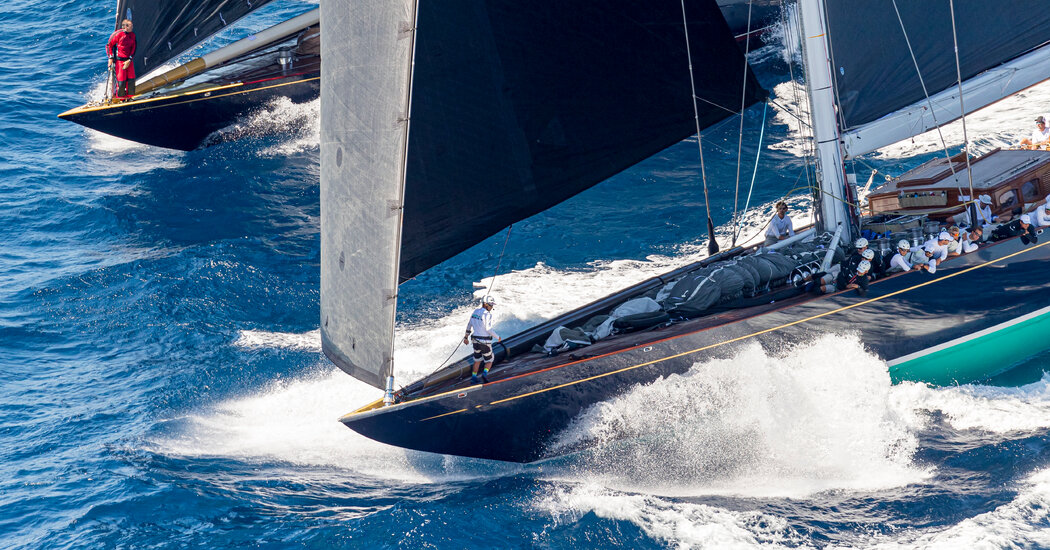
Falling off the deck of a giant J-Class yacht is not an everyday thing, but there is risk enough that each J in competition has a chase boat to rescue sailors who do fall. Imagine manhandling enormous sails on a narrow, slanting, pitching deck without the protective fencing of the lifelines that are standard on other boats.
There are no lifelines on J-Class boats because they would interfere with tacking the enormous forward sails, the jibs. And then there’s a century of tradition: Those lines would compromise the boat’s classic looks.
Around 50 boats are competing in the Maxi Yacht Rolex Cup starting on Monday in Porto Cervo, Sardinia, including four J-Class yachts. While many of the boats will be 60- to 80-feet long, Js are well over 100 feet, with masts much taller than that. They tower majestically over other boats.
“The Js have the most graceful shape imaginable, and in their sheer scale they project a sense of grandeur that no other boats can match,” said John Kostecki, an Olympic medalist and America’s Cup winner. “The first time you see them on the water, they take your breath away.”
J-Class yachts had their own era in America’s Cup history. They were built from specifications laid down at the turn of the last century and chosen three times for America’s Cup matches between the United States and Britain from 1930 to 1937.
The original Js were extravagant throwaways, intended only for racing. Not one was kept in sailing trim through World War II. What wasn’t salvaged for war materials was simply abandoned. Original J-Class yachts were never intended for casual weekend sailing, and they had outlived their purpose for competition.
J-Class designs have since been resurrected by a few owners who can afford to indulge themselves in their beauty and romance. There are now seven in the world.
One competing in Sardinia is Velsheda, which was built in 1933 and abandoned in the mud in 1937. It was rescued in 1984 and now is owned and helmed by the Dutch businessman Ronald de Waal. It looks 1933-fresh after an extensive renovation.
The other Js racing on Monday are replicas of boats long discarded or designed but never built, and now constructed to modern standards and with modern features, like the 135-foot Ranger. Harold Vanderbilt defended the America’s Cup on the original Ranger in 1937.
The replica Ranger will be helmed by the 2007 America’s Cup winner Ed Baird, with Kostecki as the tactician.
Svea and Topaz are also replicas. Svea had been designed but not built in 1937, intended for a Swedish America’s Cup challenge that was canceled because of the war. It was launched in 2017, and its primary winches — for controlling the enormous sails — are customized for different maneuvers at different, hydraulically powered, computer-controlled rates of speed.
At 143 feet long with 176 feet of carbon mast, Svea is the longest and newest J.
Topaz, a 1935 design, was built in 2015 and will by helmed in Sardinia by Peter Holmberg, an Olympic medalist and America’s Cup winner.
In building replicas, there is no forgiveness in design below the water. However, compromises are allowed elsewhere. One such compromise is the gleaming house that rides above the deck on Ranger. Vanderbilt’s Ranger had no house for lounging in the shade, but the new house is a comfort spot for the owner and guests when the boat is not racing. During regattas, Kostecki said the structure was a visual obstacle for Baird.
Different lengths and weights also produce differences in performance. New boats are faster than old boats, in part because of the ability of modern materials and engineering to carry more tension on the forestay — linking the top of the mast to the front of the boat — to prevent sagging of the sails.
Tom Dodson of New Zealand, a sailmaker and tactician on Velsheda, said: “The new boats might carry 36 tons of load on the forestay. Velsheda at age 89 can handle at most 22 tons before the boat starts to twist and flex, but that’s still a lot of cars hanging off your mast.”
A time correction formula used in regattas allows boats launched decades apart to compete fairly.
“Some factors can be calculated and others can’t, but the boats are so big and so heavy that they push through the water at close to the same speed. The latest correction system seems to be working. Velsheda wins races. Topaz and Svea both won races in July at Palma,” Dodson said, referring to the Superyacht Cup in Spain.
Helming these boats is not stress free. Given their tonnage and outdated configuration, the long keel in particular, Js do not turn on a dime.
“These are far and away the hardest of all boats to steer accurately,” Dodson said. “When I have to step in [at the helm], maybe while Ron wipes his sunglasses, my heart rate shoots up. Along with responsibility for the safety of all, at the end of the day, if it’s a job well done that’s a lot of satisfaction — respect due.”
Francesco de Angelis has skippered in the America’s Cup for Italy and has sailed on many of the J-Class yachts now in commission.
“I began with Endeavour, the first of the three original Js to be restored,” he said. “I was curious because the class was such a milestone in yachting.”
As tactician now for Topaz, de Angelis said, “Because the boats are not highly maneuverable, gauging time and distance to the starting line requires you to commit to your approach with three minutes left in the countdown to the start.
“On the course, you can’t afford to make many maneuvers, so you have to choose well and execute well.” Once committed to a tack, “there’s no turning back.”